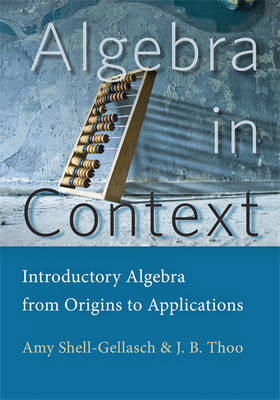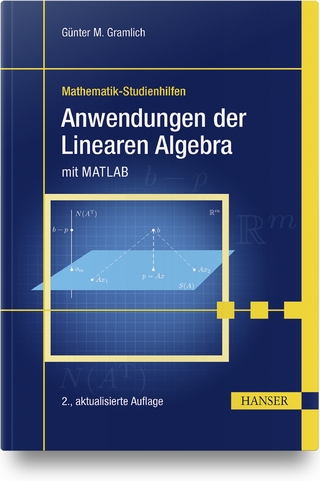
Algebra in Context
Johns Hopkins University Press (Verlag)
978-1-4214-1728-8 (ISBN)
This book's unique approach to the teaching of mathematics lies in its use of history to provide a framework for understanding algebra and related fields. With Algebra in Context, students will soon discover why mathematics is such a crucial part not only of civilization but also of everyday life. Even those who have avoided mathematics for years will find the historical stories both inviting and gripping. The book's lessons begin with the creation and spread of number systems, from the mathematical development of early civilizations in Babylonia, Greece, China, Rome, Egypt, and Central America to the advancement of mathematics over time and the roles of famous figures such as Descartes and Leonardo of Pisa (Fibonacci). Before long, it becomes clear that the simple origins of algebra evolved into modern problem solving. Along the way, the language of mathematics becomes familiar, and students are gradually introduced to more challenging problems. Paced perfectly, Amy Shell-Gellasch and J. B. Thoo's chapters ease students from topic to topic until they reach the twenty-first century.
By the end of Algebra in Context, students using this textbook will be comfortable with most algebra concepts, including: different number bases; algebraic notation; methods of arithmetic calculation; real numbers; complex numbers; divisors; prime factorization; variation; factoring; solving linear equations; false position; solving quadratic equations; solving cubic equations; nth roots; set theory; one-to-one correspondence; infinite sets; figurate numbers; logarithms; exponential growth; and interest calculations.
Amy Shell-Gellasch is an associate professor of mathematics at Montgomery College. She is the editor of Hands on History: A Resource for Teaching Mathematics, the author of In Service to Mathematics: The Life and Work of Mina Rees, and the coeditor of From Calculus to Computers: Using the Last 200 Years of Mathematics History in the Classroom. J. B. Thoo is a mathematics instructor at Yuba College.
Preface
Introduction
Part I
1. Number Bases
1.1. Base 6
1.2. Base 4
2. Babylonian Number System
2.1. Cuneiform
2.2. Mathematical Texts
2.3. Number System
3. Egyptian and Roman Number Systems
3.1. Egyptian
3.1.1. History
3.1.2. Writing and Mathematics
3.1.3. Number System
3.2. Roman
3.2.1. History
3.2.2. Number System
4. Chinese Number System
4.1. History and Mathematics
4.2. Rod Numerals
5. Mayan Number System
5.1. Calendar
5.2. Codices
5.3. Number System
5.4. Native North Americans
6. Indo-Arabic Number System
6.1. India
6.1.1. History
6.1.2. Mathematics
6.2. The Middle East
6.2.1. History
6.2.2. Mathematics
6.3. Number System
6.3.1. Whole Numbers
6.3.2. Fractions
7. Exercises
Part II
8. Addition and Subtraction
9. Multiplication
9.1. Roman Abacus
9.2. Grating or Lattice Method
9.3. Ibn Labban and Chinese Counting Board
9.4. Egyptian Doubling Method
10. Division
10.1. Egyptian
10.2. Leonardo of Pisa
10.3. Galley or Scratch Method
11. Casting Out Nines
12. Finding Square Roots
12.1. Heron of Alexandria
12.2. Theon of Alexandria
12.3. Bakhshalı Manuscript
12.4. Nicolas Chuquet
13. Exercises
Part III
14. Sets
14.1. Set Relations
14.2. Finding 2n
14.3. One-to-One Correspondence and Cardinality
15. Rational, Irrational, and Real Numbers
15.1. Commensurable and Incommensurable Magnitudes
15.2. Rational Numbers
15.3. Irrational Numbers
15.4. I Is Uncountably Infinite
15.5. card(Q), card(I), and card(R)
15.6. Transfinite Numbers
16. Logic
17. The Higher Arithmetic
17.1. Early Greek Elementary Number Theory
17.1.1. Pythagoras
17.1.2. Euclid
17.1.3. Nicomachus and Diophantus
17.2. Even and Odd Numbers
17.3. Figurate Numbers
17.3.1. Triangular Numbers
17.3.2. Square Numbers
17.3.3. Rectangular Numbers
17.3.4. Other Figurate Numbers
17.4. Pythagorean Triples
17.5. Divisors, Common Factors, and Common Multiples
17.5.1. Factors and Multiples
17.5.2. Euclid's Algorithm
17.5.3. Multiples
17.6. Prime Numbers
17.6.1. The Sieve of Eratosthenes
17.6.2. The Fundamental Theorem of Arithmetic
17.6.3. Perfect Numbers
17.6.4. Friendly Numbers
18. Exercises
Part IV
19. Linear Problems
19.1. Review of Linear Equations
19.2. False Position
19.3. Double False Position
20. Quadratic Problems
20.1. Solving Quadratic Equations by Completing the Square
20.1.1. Babylonian
201.2. Arabic
201.3. Indian
20.1.4. The Quadratic Formula
20.2. Polynomial Equations in One Variable
20.2.1. Powers
20.2.2. nth Roots
20.3. Continued Fractions
20.3.1. Finite Simple Continued Fractions
20.3.2. Infinite Simple Continued Fractions
20.3.3. The Number
21. Cubic Equations and Complex Numbers
21.1. Complex Numbers
21.2. Solving Cubic Equations and the Cubic Formula
22. Polynomial Equations
Relation between Roots and Coefficients
Viète and Harriot
22.3. Zeros of a Polynomial
22.3.1. Factoring
22.3.2. Descartes's Rule of Signs
22.4. The Fundamental Theorem of Algebra
23. Rule of Three
23.1. China
23.2. India
23.3. Medieval Europe
23.4. The Rule of Three in False Position
23.5. Direct Variation, Inverse Variation, and Modeling
24. Logarithms
24.1. Logarithms Today
24.2. Properties of Logarithms
24.3. Bases of a Logarithm
24.3.1. Using a Calculator
24.3.2. Comparing Logarithms
24.4. Logarithm to the Base e and Applications
24.4.1. Compound Interest
24.4.2. Amortization
24.4.3. Exponential Growth and Decay
24.5. Logarithm to the Base 10 and Application to Earthquakes
25. Exercises
Bibliography
Index
| Erscheint lt. Verlag | 10.12.2015 |
|---|---|
| Zusatzinfo | 9 Maps; 12 Line drawings, black and white; 28 Illustrations, black and white |
| Verlagsort | Baltimore, MD |
| Sprache | englisch |
| Maße | 178 x 254 mm |
| Gewicht | 1293 g |
| Themenwelt | Mathematik / Informatik ► Mathematik ► Algebra |
| Mathematik / Informatik ► Mathematik ► Geschichte der Mathematik | |
| ISBN-10 | 1-4214-1728-6 / 1421417286 |
| ISBN-13 | 978-1-4214-1728-8 / 9781421417288 |
| Zustand | Neuware |
| Haben Sie eine Frage zum Produkt? |
aus dem Bereich


